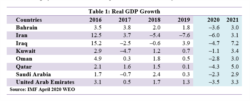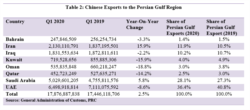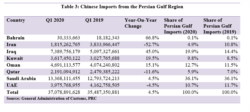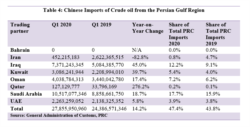Chinese customs data for the first three months of 2020 show an increase in both exports to and imports from the Persian Gulf despite a 6.8 percent contraction of Beijing’s GDP brought on by the COVID-19 pandemic. The resilience of China’s trade relations with the Persian Gulf states, despite pandemic-related disruptions, indicates the potential for Beijing to further enhance its influence in the region.
With ample currency reserves and a growing demand for oil, China can serve as a reliable customer for the crude exports on which regional economies depend. At a time when both parties in Washington are increasingly hesitant to defend America’s strategic position in the Gulf, China may be poised to benefit from this uncertainty.
The plunge in Chinese GDP represents the first contraction Beijing has reported since it began to publish growth figures in 1992. Likewise, the International Monetary Fund forecasts negative growth in 2020 for the eight countries in the region, although the Fund expects a strong recovery in 2021. (See Table 1)
The pandemic’s impact on Persian Gulf economies reflects a sharp decrease in the price of oil that has compounded the impact of restrictive public health measures. Foreign demand for oil has fallen sharply, but a Saudi decision to flood the market was also instrumental into bringing the price per barrel for Brent Crude down to roughly $20, or one-third of its price at the end of January.
While the contraction of Chinese GDP led to a 13.3 percent decline in exports and a 2.9 percent reduction in imports overall in the first quarter, Beijing’s exports to the Persian Gulf as well as its imports from the region both rose in that period. Imports rose 4.5 percent, mainly on the strength of a 14.2 increase by value in crude oil purchases. Exports to the region rose mainly because of increased purchases by Saudi Arabia and Iran, which offset falling numbers for the region’s other six countries.
Beijing’s trade relations with the Persian Gulf are lopsided; the region’s eight countries send twice as much to China in the form of exports as they buy in imports. In the first quarter of 2020, the region took $17.9 billion of Chinese imports, while sending back $37.1 billion of exports. Of that number, $27.9 billion, or three-quarters, consisted of crude oil. China imported $59 billion of crude during the first quarter, so Persian Gulf oil comprised nearly half of Chinese imports.
There is also unevenness in China’s relations with the eight countries that border Persian Gulf. Saudi Arabia and the United Arab Emirates take in about two-thirds of Chinese goods, in keeping with the greater size of their economies compared to their neighbors. Meanwhile the Saudis sell more than one-third of the Persian Gulf oil that goes to China, with Iraq providing another fifth. (See Table 2 and Table 3)
Iran is an outlier because U.S. sanctions have had a dramatic impact on its exports of crude oil to China, even though Beijing refuses to abide fully Washington’s restrictions. Thus, sales of Iranian crude fell by more than half from the first quarter of 2019 to the first quarter of the current year – the U.S. imposed a total ban on Iranian oil exports in May 2019. Meanwhile, Iranian imports from China increased almost 16 percent, in contrast to declines registered by every other Persian Gulf country except Saudi Arabia. This change likely reflects the intensification of sanctions as well, since European firms have mostly severed ties to Iran.
As noted above, a sharp rise in spending on Persian Gulf oil drove the overall increase in Chinese imports from the region. China bought $27.9 billion of oil from the region, up from $24.4 billion in the first quarter of 2019, an increase of 14 percent by value. By volume, China imported 59 million tonnes of crude oil from Persian Gulf in the first quarter of this year, an 11.5 percent increase over the 53 million tonnes it imported in the first quarter of 2019.
Monthly data for 2020 show the dramatic impact of price fluctuations on the cost of oil purchases. Customs data show that China imported about 86 million tonnes (43 million tonnes on average per month) of crude oil at a cost of roughly $42.2 billion ($21.1 billion on average per month) in the first two months of 2020. Then in March, the data shows imports of 41 million tonnes at a cost of only $16.7 billion – a 20 percent decrease in value despite only a five percent decrease in volume.
Fluctuations in value likely do not explain why the Persian Gulf countries’ share of Chinese crude imports rose 47.2 percent in the first quarter, up from 43.8 percent in the same period in 2019. This increase is especially notable in light of an 83 percent decrease by value in Chinese imports from Iran, leaving Iran with less than 1 percent market share by value. The region as a whole more than made up for this loss thanks to sizable increase the value of crude sold to China by Saudi Arabia, Iraq, Kuwait, and Oman.
The resilience of Persian Gulf trade relations with China bears watching. If the Persian Gulf states sense that the U.S. lacks a commitment to the region, they may become more solicitous of Beijing’s interests, given their trade relations. Chinese ties to the region have deepened consistently over the past two decades, and Beijing has the ample currency reserves necessary to sustain its oil purchases. Its lack of scruple regarding human rights is also an advantage for almost all Persian Gulf States. Yet China does not appear eager to take sides in regional disputes; thus, given the likelihood that Iran’s clerical regime will persist in its efforts to destabilize its neighbors, the United States has much to offer if it does not retreat from the region.










